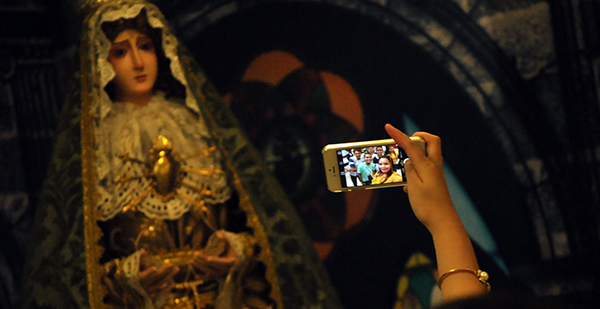
|
IN THIS PHOTO:
|
|
ORIENTAL FAITH
East meets West in the Blessed Lady of China, one of this year’s new images. Hair gathered in a bun like an empress and frocked in a deep-red robe, the icon created by artist Jodee Jose is as much Mary as Kwan Yin. |
| View Gallery |
|
IN THIS PHOTO:
|
|
KNOTS UNDID
The icon is named Nuestra Senora Desatadora de Nudos, the Undoer of Life’s Difficult Knots. Though the first of its kind in the country – it is owned by the Linsangan Family in Bocaue, Bulacan. |
| View Gallery |
|
IN THIS PHOTO:
|
|
HERMANO MAYOR
This year's feast day of Our Lady of Fatima is Arch. Glenn Encarnacion. |
| View Gallery |
|
IN THIS PHOTO:
|
|
ARCHBISHOP VILLEGAS
Archbishop Socrates Villegas swings the thurible before the image of the Virgin Mary after a brief procession from the nextdoor shrine to signal the opening of the exhibit. |
| View Gallery |
|
IN THIS PHOTO:
|
|
ARCHBISHOP'S SKULLCAP
Archbishop Socrates Villegas playfully put on his skullcap to a boy as he graces the opening of the 17th Marian Exhibit at the Museo Valenzuela. |
| View Gallery |
|
IN THIS PHOTO:
|
|
BLESSED LADY OF CHINA
A visitor snaps a picture of an image of the Blessed Lady of China. The image was originally commissioned by fashion designer Kenneth Chua, who was slain in 2014 before he could claim it. |
| View Gallery |
|
IN THIS PHOTO:
|
|
SMALL HANDS
A girl reaches out to the hand of one of the image at the 81 icons on display at the Museo Valenzuela as part of the 17th Marian Exhibit. |
| View Gallery |
|
IN THIS PHOTO:
|
|
HOLY SEAT
A devotee swabs the cross pendant of his necklace on the papal chair that highlights the 17th Marian Exhibit at the Museo Valenzuela. |
| View Gallery |
|
IN THIS PHOTO:
|
|
WIFI FAITH
A of youngsters visiting the 1th Marian Exhibit takes a selfie before one of the 81 iamges on display at the Museo Valenzuela. |
| View Gallery |


The centerpiece of this year’s Grand Marian Exhibit in Valenzuela City is not an image of the Blessed Virgin but a chair.
The 5-feet-and-a-half-high chair is the one used by Pope Francis during the mass at the Quirino Grandstand that capped his five-day state visit in January.
Designed by the Rev. Alex Bautista and built by the artisans of VitreArtus Liturgical Arts in Laguna, the mahogany chair adapts a Filipino motif: the top of the arced backrest is decorated with a bas relief of a shepherd and the words Ang Mabuting Pastol. Along the backrest’s round edge are anahaw fronds.
Carlo Verdadero, exhibit committee co-chair, said the Papal Chair originally comes with a table and ambo, which are now kept in a church in Sta. Rosa, Laguna.
The Grand Marian Exhibit is held annually by the Our Lady of Fatima Parish in Brgy. Marulas, together with Museo Valenzuela Foundation, in celebration of the patron’s feast day in May. For the last 16 years, the exhibit at the Museo Valenzuela has regaled visitors with a profusion of richly attired icons, some of them century-old family heirlooms.
East meets West
At a total of 81, more images are on display today than last year, which had 68 images.
A perennial item is the Our Lady of Fatima, the image held high by the crowd of protesters during the EDSA People Power in 1986; so are the cute La Bambina, the swaddled infant Mary, and La Niña Maria, Mary as a toddler.
While the majority of the images takes a European appearance, some particularly mirror the Asian faithful.
The Ina ng Sangkapulaan ng Pilipinas eschews the ivory white complexion that has become synonymous to Marian images in favor of a darker one. She wears a Spanish-era baro’t saya, while the baby Jesus is donned in a frilly white barong Tagalog.
East meets West in the Blessed Lady of China, one of this year’s new images. Hair gathered in a bun like an empress and frocked in a deep-red robe, the icon created by artist Jodee Jose is as much Mary as Kwan Yin, the bodhisattva of compassion venerated by East Asian Buddhists. The image was originally commissioned by fashion designer Kenneth Chua, who was slain in 2014 before he could claim it.
Beyond visual
Verdadero, however, wants the exhibit to be more than a visual feast. The prayer that comes with each curatorial note is meant to encourage contemplation among visitors, he said.
In one of the images, on the piece of rope held by Mary, visitors can also hang slips of paper that bear their prayers. Four days after the exhibit opened, the rope is almost covered with paper, much like the strings of omikuji seen at Shinto shrines in Japan.
The icon is named Nuestra Senora Desatadora de Nudos, the Undoer of Life’s Difficult Knots. Though the first of its kind in the country – it is owned by the Linsangan Family in Bocaue, Bulacan – devotion to the Desatadora in Europe has been around since 1700s. Its most famous devotee today, who paid homage in a speech in October 2013, is Pope Francis.
Catholic Bishops Conference of the Philippines (CBCP) president and Archdiocese of Lingayen-Dagupan Archbishop Socrates Villegas graced the opening of the exhibit.
 Latest News
Latest News Archive
Archive Category
Category

